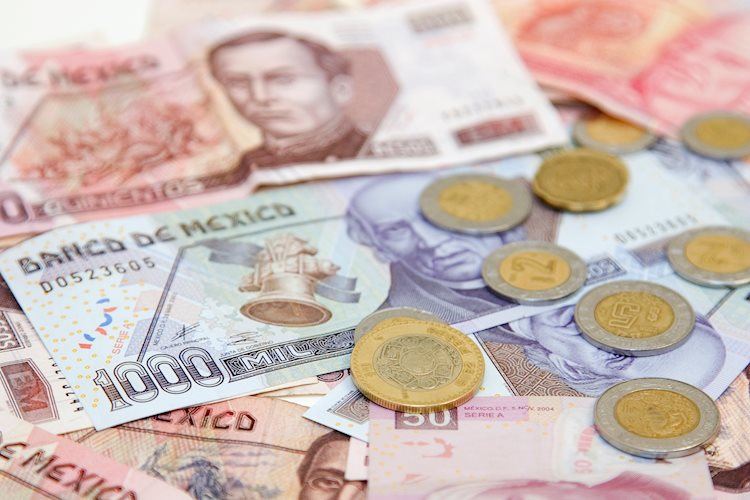- Mexican Peso dampened by a Fed official pushing back against interest rate cuts.
- The economy in the United States remains solid, according to a report by S&P Global.
- New York Fed President John Williams pushes back against rate cuts, a tailwind for USD/MXN.
- A Banxico survey shows economists expect 200 bps of rate cuts for 2024.
Mexican Peso (MXN) stays firm, reversing earlier losses against the US Dollar (USD) after the central bank bonanza on both sides of the border is finished. The divergence between the US Federal Reserve (Fed) and the Bank of Mexico (Banxico) would likely keep the USD/MXN pair trading below 18.00 for the remainder of the year. At the time of writing, the exotic pair trades at 17.18, virtually unchanged, down 0.02%.
Banxico held rates unchanged at 11.25% and maintained the tone set in the November meeting. That sponsored a leg-down in the pair, further distancing from the 100-day Simple Moving Average (SMA) key resistance level at 17.41 toward current exchange rate levels. However, the United States (US) data was solid enough to keep the pair from reaching the 17.03 latest cycle low.
In the meantime, a Banxico survey revealed that Mexican economists raised their growth forecast for 2024 from 2.10% to 2.29%, while inflation is expected to hit 4% next year. Regarding monetary policy, they expect the central bank to cut rates by 200 bps to 9.25 and the Peso to depreciate from 18.69 to 18.53.
Daily Digest Market Movers: Mexican Peso bolstered by Banxico hawkish hold
- Banxico’s decision was unanimously supported by its five members.
- The central bank acknowledged that inflation risks are tilted to the upside after November’s report witnessed headline inflation rising due to the “rise in non-core components” while core inflation eased.
- Banxico revised its inflation projections for some quarters of 2024 and 2025.
- Business activity picked up in December, according to S&P Global. The composite index, which combines manufacturing and services sectors, increased to 51, exceeding November’s 50.7 and hitting a five-month high.
- The services PMI subcomponent came in at 51.3, exceeding forecasts of 50.6, though Manufacturing slipped further, dropping to 48.2, below estimates of 49.3, and November’s 49.4
- Aside from this, the New York Fed President John Williams pushed back against the idea of rate cuts, emphatically saying it’s “premature” to think about easing policy in March.
- Williams added that the question around the Fed board is whether the policy is sufficiently restrictive enough to ensure inflation returns to 2%.
- US data on Thursday painted the economy as more resilient than expected as Retail Sales exceeded forecasts, while unemployment claims rose less than estimates.
- According to the Summary of Economic Projections (SEP), Fed officials expect to lower the federal funds rates (FFR) to 4.60% in 2024, though they remain data-dependent.
- The fall in US Treasury Bond yields, which are closely correlated to the Greenback (USD) has stalled relief for the USD, which is rising 0.43%, up at 102.40, according to the US Dollar Index (DXY).
- Money market futures estimate the Fed will slash rates by 140 basis points toward the end of next year, twice the Fed’s forecasts of three 25 bps cuts.
Technical analysis: Mexican Peso to remain range-bound at around 17.00-17.60
The USD/MXN bias is neutral to downwards biased after dropping below the 100-day SMA, seen as the last line of defense by buyers. That exposed the 17.00/05 area as the next demand area, which once surpassed, could open the door for a retest of the year-to-date (YTD) low of 16.62
On the other hand, if buyers reclaim the 100-day SMA at 17.41, the USD/MXN could rally toward the 200-day SMA at 17.52, followed by the 50-day SMA at 17.60. Further upside is seen at around 18.00.
Banxico FAQs
The Bank of Mexico, also known as Banxico, is the country’s central bank. Its mission is to preserve the value of Mexico’s currency, the Mexican Peso (MXN), and to set the monetary policy. To this end, its main objective is to maintain low and stable inflation within target levels – at or close to its target of 3%, the midpoint in a tolerance band of between 2% and 4%.
The main tool of the Banxico to guide monetary policy is by setting interest rates. When inflation is above target, the bank will attempt to tame it by raising rates, making it more expensive for households and businesses to borrow money and thus cooling the economy. Higher interest rates are generally positive for the Mexican Peso (MXN) as they lead to higher yields, making the country a more attractive place for investors. On the contrary, lower interest rates tend to weaken MXN. The rate differential with the USD, or how the Banxico is expected to set interest rates compared with the US Federal Reserve (Fed), is a key factor.
Banxico meets eight times a year, and its monetary policy is greatly influenced by decisions of the US Federal Reserve (Fed). Therefore, the central bank’s decision-making committee usually gathers a week after the Fed. In doing so, Banxico reacts and sometimes anticipates monetary policy measures set by the Federal Reserve. For example, after the Covid-19 pandemic, before the Fed raised rates, Banxico did it first in an attempt to diminish the chances of a substantial depreciation of the Mexican Peso (MXN) and to prevent capital outflows that could destabilize the country.

